Wild horses are America’s treasure. According to the Bureau of Land Management, about 41,000 horses and 8,000 burros roam on BLM-managed rangelands in 10 Western states. Up to the moment they’re captured, wild horses spend all their lives surviving on the range. They’re culled by nature to be the hardiest, most rugged trail prospects in the horse world.
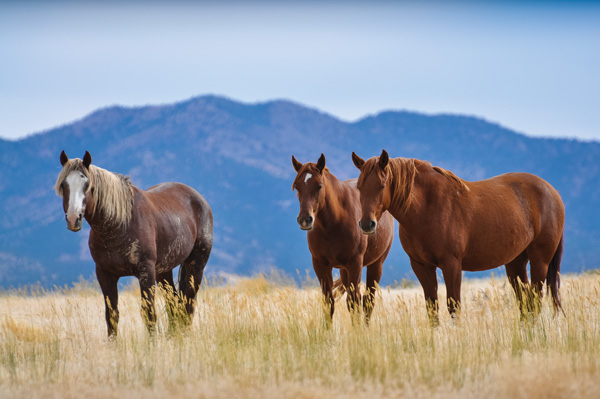 Photo Courtesy Of the BLM
Photo Courtesy Of the BLMThe number of horses the BLM rounds up per year varies. The BLM’s goal is to keep the free-roaming wild horse and burro population at about 26,000; roundups are performed frequently in the fall and winter with this goal in mind. Approximately 48,000 wild horse and burros are currently being kept by the BLM in short-term corrals and long-term pastures.
Taking on a wild horse can be a challenge, but with the right care and handling, you can find yourself with a savvy, surefooted trail companion.
Here, we’ll first help you determine whether a wild horse is right for you. Then we’ll detail several ways to adopt a wild horse. Next, we’ll give you post-adoption guidelines, including expert feeding and gentling tips.
Note: The terms “mustang” and “wild horse” are frequently used interchangeably. Here, we’ll use the term “wild horse” to describe any horse that is or was once wild, regardless of bloodlines.
Wild Horse Challenges
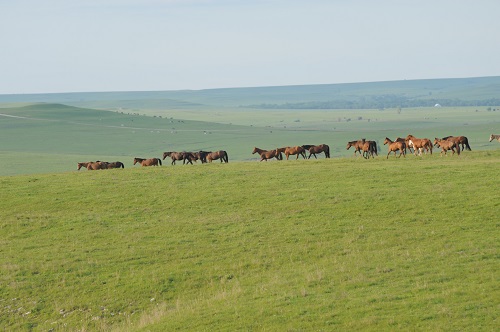 Photo Courtesy of the BLM
Photo Courtesy of the BLMThe notion of adopting a wild horse is a romantic one. But adopting a wild horse in any stage of training can be challenging. Before you adopt, make sure you’re equipped to take on these challenges. Following are four key things to keep in mind.
• Your horse experience. Wild horses for adoption range from unhandled horses to those with some training. All ages are represented, from weanlings to mature horses. An untamed or greenbroke wild horse isn’t the best choice for a novice rider. Only consider owning a wild horse if you’re a seasoned, knowledgeable rider. Even then, you might need the help of a professional trainer.
• Your horse housing. If you plan to adopt a wild horse through the BLM, note that the agency has stringent horse-housing requirements. (For details, see the BLM website.) Private mustang-adoption organizations also have facility requirements. Investigate online before you take steps to adopt an animal. Before you bring the horse home, inspect the enclosure. Make sure the space is safe and free of hazardous objects.
• Your budget. Owning a wild horse requires a substantial financial commitment. Unless you’re an experienced horse handler, you’ll likely need to hire a trainer to help you gentle and saddle train your horse. Add this cost to what you think you’ll spend per year for feed, veterinary care, farrier work, tack, board, and other miscellaneous expenses.
• Your time constraints. Do you truly have what it takes in terms of time and experience to give a good home to a wild horse? You’ll need to spend time earning your wild horse’s trust. Plan to spend hours just hanging out with him to build a relationship. You’ll also need to stay intimately involved in your horse’s training, even if you use a professional trainer, to maintain the bond you’ve developed with your horse.
Adoption Methods
You can either adopt a horse through the BLM’s adoption program or a wild horse rescue facility.
For wild horses in need, rescues step in to provide a temporary home, along with rehabilitation and training. Once a horse is ready for a new home, the horse is adopted out for a fee. Each rescue has its own adoption requirements. Reputable rescues are careful to match each horse with the right owner. Most rescues offer ongoing support to new owners to help them bond with their mustangs.
The BLM adopts out horses and burros through its Wild Horse and Burro Program. You can visit an adoption facility, attend an adoption event, adopt a horse online, or purchase a horse from the BLM via private sale. The BLM retains title to the horse for one year past the date of adoption; full ownership of the horse then transfers to you, the adopter.
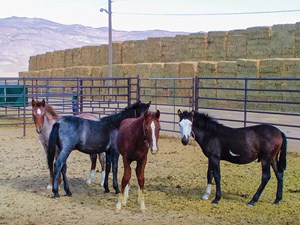 Photo Courtesy of the BLM
Photo Courtesy of the BLMHere’s a rundown of each adoption method, plus transport tips.
• Go to an adoption facility. If you choose to adopt a wild horse from a BLM adoption facility, you’ll visit a set location where animals are kept and choose the horse you’d like to adopt.
The BLM maintains adoption facilities in Arizona, California, Colorado, Idaho, Kansas, Mississippi, Nebraska, Nevada, Oklahoma, Oregon, Utah, and Wyoming. If you meet adoption requirements, you’ll make an appointment with the closest facility, submit an adoption application, and pay a $125 adoption fee.
• Go to an adoption event. Adoption events take place around the country all year long. These events are held in conjunction with stock shows, horse expos, competitive wild horse events, county fairs, and other activities. In some cases, horses are auctioned off; in others, horses are available though regular adoption procedures.
• Adopt online. The BLM’s Internet Adoption Program allows you to view photos of horses for adoption online and bid on the horse you’d like to adopt. Bidding is conducted during specific time periods. The minimum bid is $125; bids typically go up in small increments. To bid, you must meet the adoption requirements and complete an adoption application. Once the bidding is complete, you may ask the BLM to move the horse to a closer adoption facility to make it easier for you to pick him up.
• Adopt via private sale. Animals eligible for private sale are those over 10 years old and younger horses that have been passed over for adoption at least three times. In this adoption method, the title of ownership passes immediately from the federal government to you, the buyer. If you choose this route, note that you must still meet the BLM’s adoption requirements.
• Transport tips. No matter what adoption method you choose, it’s your responsibility to transport your new horse to your facility. The BLM requires that you use a trailer designed to accommodate at least three horses. Plus, the trailer must not have a manger, divider, or anything else that the horse could try to jump over. Open stock trailers work best.
Feeding Facts
Once you’ve adopted your wild horse, the work has just begun. You’ll need to further prepare your facility and transition your new horse to a new feeding program. First, provide a half-barrel or trough for water rather than an automatic waterer, and a ground-feeder for hay. This will lower the chances that your horse will avoid drinking or eating because he’s afraid of a strange waterer or feeder.
Plan your wild horse’s feeding program well in advance. Match the feeding program he was on at his prior living situation. If you want to change his diet, do it very slowly to avoid colic. “Horses in the wild rarely experience colic,” says equine nutritionist Juliet Getty, PhD. “One of the main reasons for colic in the domesticated situation is the rapid change from one feed to another, leaving the bacterial hindgut population little time to adjust. “These microbes are responsible for digesting the fiber found in hay or pasture and need to be protected.”
Dr. Getty recommends providing freechoice grass hay to your wild horse, using a slow feeder. “Horses, as grazing animals, are designed to consume forage virtually all day and night, taking a few minutes here and there to rest,” Dr. Getty explains. “Their consistent chewing produces acid-neutralizing saliva, thereby preventing ulcers. Walking to find that next tasty bite exercises the digestive-tract muscles, helping to protect against colic.”
Dr. Getty suggests supplementing your horse’s forage with nutrients. “Hay, which is dead grass, no longer contains the vitamins found in the wild horse’s previous, varied diet,” she notes. “You’ll need to fill the horse’s nutrition
gaps to match the rich nutrition of the wild environment.”
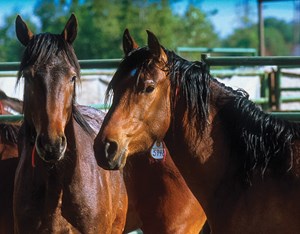 Photo Courtesy of the BLM
Photo Courtesy of the BLMTo fill these gaps, Dr. Getty recommends vitamin and mineral supplements, along with chia seeds and ground flaxseeds as a source of omega-3 fatty acids.
Handling Help
Your handling approach will depend on how much gentling the horse has already experienced. If you adopt a wild horse from a BLM adoption facility, he likely will have had little handling and will need to be gentled.
Wild horses adopted from rescues or from competitive mustang training events have been handled and have had some training.
Wild horses that have not been handled pose the greatest training challenge. Before you can do any kind of training, the horse must learn to trust you.
“The most important thing a new mustang owner must know is that the horse needs time,” says natural-horsemanship trainer and clinician Anna Twinney, founder of Reach Out to Horses in Elizabeth, Colorado.
“The horse needs time to transition. We need to realize that he was pulled off the range, and taken from his freedom and his family. It’s important to have compassion and realize everything the horse has been through.”
The amount of time the horse needs to bond with you will depend on the horse, says Twinney.
“Some will come right up and want interaction,” she says. “Within a day or two, if the horse has been allowed to settle in, the horse will volunteer to interact. Some horses take longer than others. If you initially keep the horse in a paddock, rather than in a large pasture, the horse will be encouraged to volunteer sooner.”Twinney advises against driving a wild horse in a round-pen to try to force him to engage with you.
“Pushing a wild horse in a round pen triggers the horse’s flight, fight, or freeze
response,” she says. “You’ll trigger the horse’s prey instinct. Gentling isn’t supposed to be about fear. You need to gain the horse’s trust. A wild horse doesn’t understand being driven, because there’s no relationship yet between the horse and the handler.”
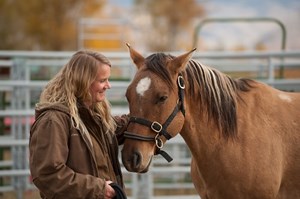 Credit: Photo courtesy of CLIXPHOTO The amount of time the horse needs to bond with you will depend on the horse, says natural-horsemanship trainer Anna Twinney (shown).
Credit: Photo courtesy of CLIXPHOTO The amount of time the horse needs to bond with you will depend on the horse, says natural-horsemanship trainer Anna Twinney (shown).Twinney’s method of gentling wild horses focuses on teaching the horse that being handled is safe. While it requires time and patience, the end results are worth the effort. “Once you build that base of trust, the rest will come together painlessly,” she says. Twinney advises hiring a trainer that has experience with wild horses, because wild horses are different from domestic horses. She also suggests avoiding trainers who won’t let you visit a horse in training and those who make claims about what they can accomplish with a horse in a fixed amount of time.
“A trainer needs to go with the speed of the horse,” Twinney says. “The trainer should be willing to show the horse compassion and have enough patience to build trust with the horse. You want a trainer who’s open to whatever may come.”
Most important, Twinney says, is finding a trainer who’ll be gentle with your wild horse. “It should be all about communicating with the horse, not using force.”
As you gentle and train your wild horse, note that you’re not alone. Wild horse owners support one another through such organizations as the Mustang and Burro Association, the US Wild Horse and Burro Association, and the Wild Horse and Burro Association.
You may also wish to attend the Western States Wild Horse & Burro Expo to be held from July 31 to August 2, 2015, in Gardnerville, Nevada.
You’ll find hope and encouragement throughout the journey as you work to make your wild horse a loyal, trustworthy trail mount and devoted equine friend.
Audrey Pavia, an award-winning freelance writer based in Norco, California, is a competitive trail rider and member of the North American Trail Ride Conference. She’s the author of Trail Riding: A Complete Guide (Howell Book House imprint of Wiley; www.howellbookhouse.com)
WILD HORSE RESOURCES
American Mustang and Burro Association, Inc. ambainc.net
Bureau of Land Management Wild Horse & Burro Program (800) 370-3936 www.blm.gov/adoptahorse
Ever After Mustang Rescue (207) 284-7721 www.mustangrescue.org
Extreme Mustang Makeover (512) 869-3225 www.extrememustangmakeover.com
Hidden Valley Wild Horse Protection Fund (775) 461-2121 www.wildhorseadoption.org
Livesavers Wild Horse Rescue (661) 727-1205 www.wildhorserescue.org
Mustang Heritage Foundation (512) 869-3225 www.mustangheritage foundation.org
Mustangs to the Rescue (541) 330-8943 www.mustangstotherescue.org
Mustang-Spirit Equine Rescue (760) 807-7558 www.mustang-spirit.org
Reach Out to Horses (303) 642-7341 www.reachouttohorses.com
US Wild Horse & Burro Association, Inc. (732) 742-5044 www.uswhba.org
Western States Wild Horse & Burro Expo (775) 843-1314 www.wildhorseandburroexpo.com
Wild Horse & Burro Association www.wildhorseburro.com
Wild Horse Rescue Center (321) 427-1523 www.wildhorserescuecenter.org





